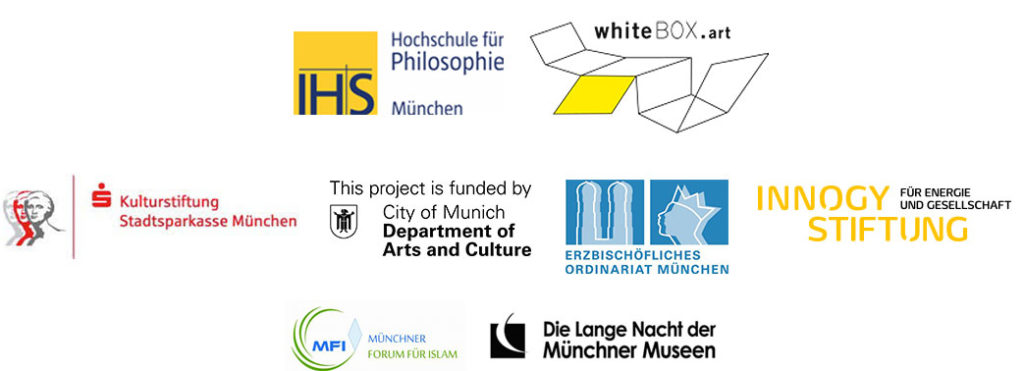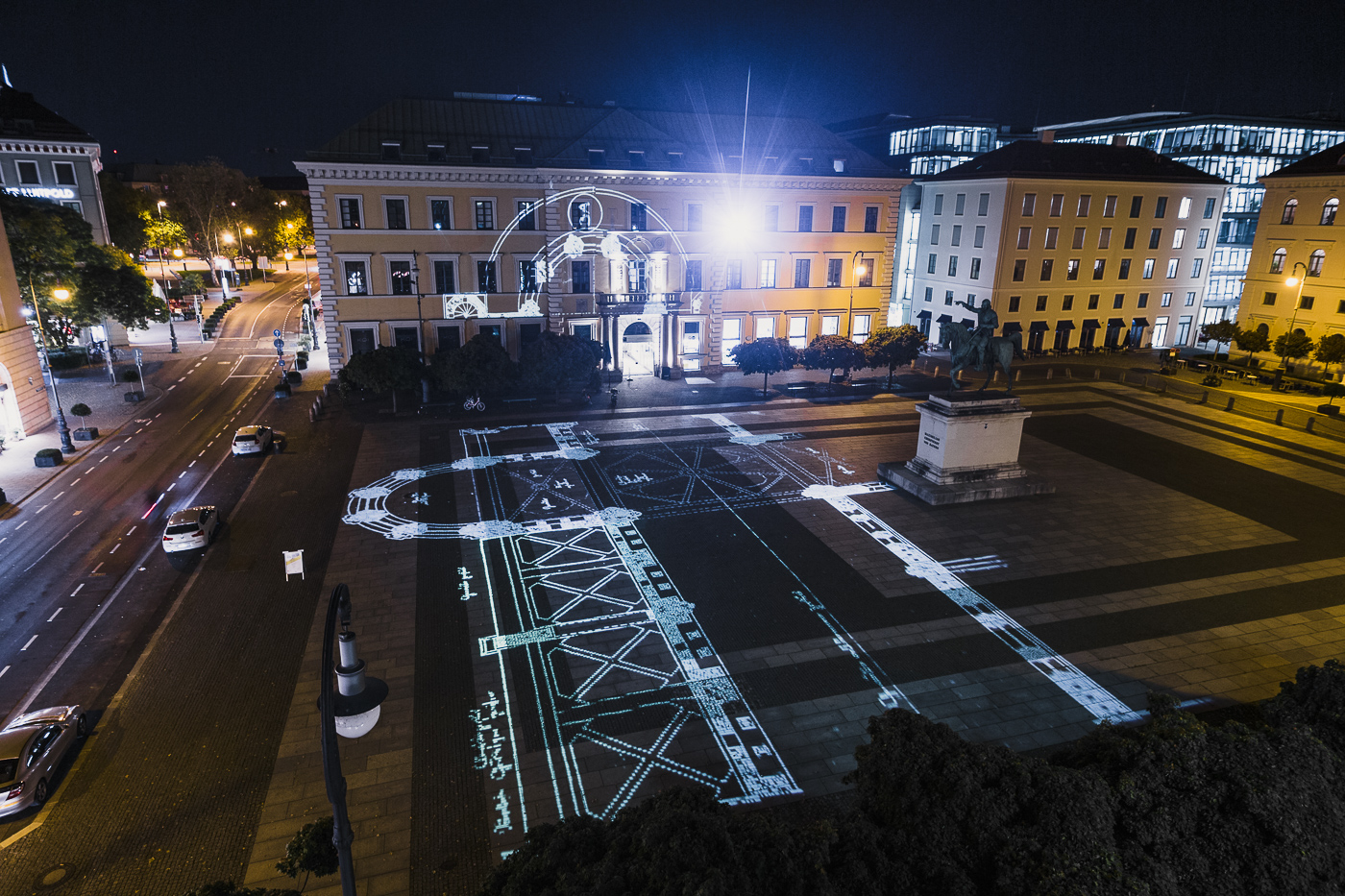Interdisciplinary art project with Prof. Michael Reder
Art intervention in public space, projection, Wittelsbacherplatz, Munich, DE, 2019
Invited as Artist in Residence by WhiteBOX
The core of the interdisciplinary art project is a publicly accessible art installation which builds on the approachability, experienceability and emotional perceptibility of the sensitive and supercharged inter-cultural and inter-religious themes through a large-scale light intervention in urban space in Munich. EASTERN MUNICH takes a look at the city of Munich itself, explores it in its multiple perspectives and returns the gained insights and experiences back to the city in multifaceted ways.
Based on the question of visibility and manifestation of religion in cityscapes, white lines of light floor plans depicting sacred buildings and spaces of the three monotheistic world religions – from Munich’s city foundation in 1158 and reaching into the future – are made visible as 1:1 projections in order to open up unknown perspectives and insights, to connect them with each other and make their peculiarities, similarities and tensions experienceable.
The sacred buildings and rooms open up, surround the perceiver, become accessible and can be experienced in their size, form, variety and significance.
The non-manifest depiction of visual forms through pure light lends lightness to the complex themes and makes it possible to approach the foreign, the other, the politically charged less biased.

Wittelsbacherplatz
Wittelsbacher-Platz is located in the immediate vicinity of Odeonsplatz, a central square that is also the starting point for the Long Night of Munich’s Museums.
The equestrian statue of Maximilian I. is a counterpoint to the themes of EASTERN MUNICH, creating friction and raising questions. As an absolutist ruler within the Counter-Reformation he played an ambivalent role in cultural-religious diversity. The quantity of religious spaces existing in Munich break this attitude open and contrast it with an alternative perspective on cultural-religious plurality, with all its friction and potential.
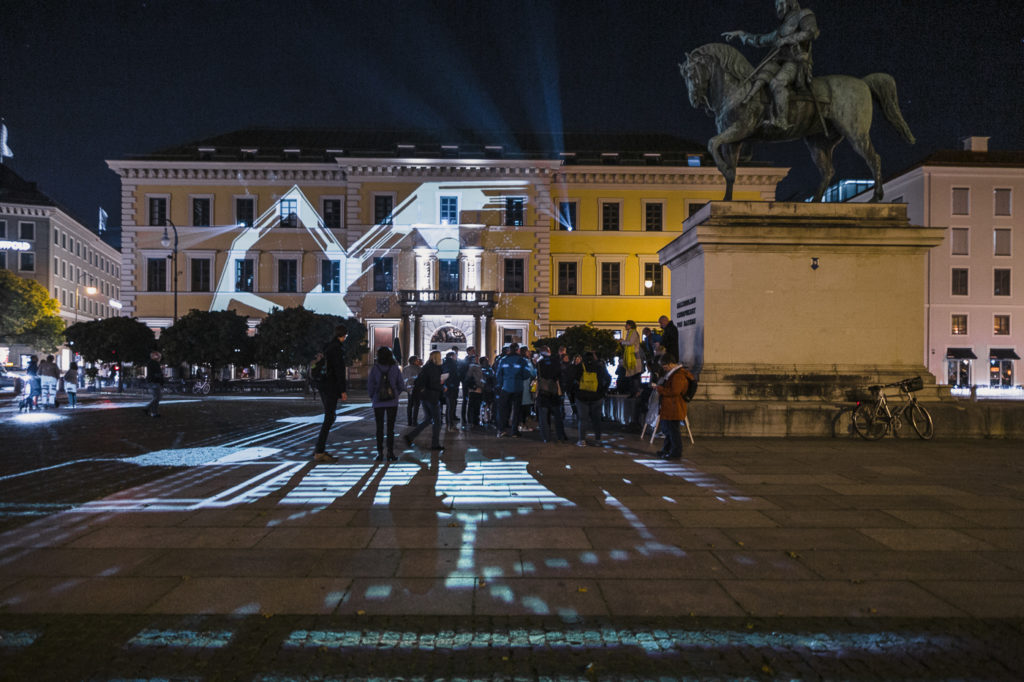
Opening
19th of October, in coop. with Lange Nacht der Münchner Museen, Wittelsbacher Platz, Munich, DE, 2019
Initiated as invited Artist in Residence program by whiteBOX Kultur gGmbH in cooperation with the Munich School of Philosophy. Developed by interdisciplinary artist Lia Sáile in collaboration with Prof. Dr. Michael Reder (Chair of Practical Philosophy, focus on international understanding at the Munich School of Philosophy).
The installation will be finalized by a discursive format, exhibition, sound piece and a book publication in May 2020.
Projection floor plan list – October 2019
111 selected floor plans out of a larger pool.
| 001 | Heilig-Kreuz-Kirche (Fröttmaning) (Catholic) |
| 002 | Jerusalemkirche (Evangelical) |
| 003 | St. Benno (Catholic) |
| 004 | Adventskirche (Evangelical) |
| 005 | Camii Moschee – Deutsch Islamisches Kulturzentrum e.V. (Muslim) |
| 006 | Christkönig (Catholic) |
| 007 | Cantatekirche (Evangelical) |
| 008 | Džemat IKRE (Muslim) |
| 009 | Friedenskirche (Evangelical) |
| 010 | Métivier-Synagoge (bis 1887) (Jewish) |
| 011 | Alte Sollner Kirche St. Johann Baptist (Catholic) |
| 012 | St. Johann Baptist (Catholic) |
| 013 | Epiphaniaskirche (Evangelical) |
| 014 | Fatih Camii (Muslim) |
| 015 | Dreifaltigkeitskirche (Catholic) |
| 016 | Immanuel-Nazareth Kirche (Evangelical) |
| 017 | Maria Schutz (Catholic) |
| 018 | anonym (Muslim) |
| 019 | St. Matthäus (Evangelical) |
| 020 | Salvatorkirche (Orthodox) |
| 021 | St. Johannes Bosco (Catholic) |
| 022 | St. Ludwig (Catholic) |
| 023 | Evangeliumskirche (Evangelical) |
| 024 | Islamische Gemeinschaft Tevhid München (Muslim) |
| 025 | Paul-Gerhardt-Kirche (Evangelical) |
| 026 | Pasinger Moschee (Haci Bayram) (Muslim) |
| 027 | St. Canisius (Catholic) |
| 028 | Wallfahrtskirche St. Anna (Catholic) |
| 029 | Gustov-Adolf-Kirche (Evangelical) |
| 030 | Freimann-Moschee (Islamisches Zentrum München) (Muslim) |
| 031 | Freimann-Moschee (Islamisches Zentrum München) (female) (Muslim) |
| 032 | Heilig-Kreuz-Kirche (Giesing) (Catholic) |
| 033 | Olympiakirche (Evangelical) |
| 034 | St. Johannes (Evangelical) |
| 035 | Philippuskirche (Evangelical) |
| 036 | Ömer Moschee (Muslim) |
| 037 | St. Clemens (Catholic) |
| 038 | St. Georg (Catholic) |
| 039 | Apostelkirche (Evangelical) |
| 040 | Mariahilfkirche (Catholic) |
| 041 | Münchner Forum für Islam e.V. (Muslim) |
| 042 | Dankeskirche (Evangelical) |
| 043 | St. Johann von Capistran (Catholic) |
| 044 | St. Martin (Untermenzing) (Catholic) |
| 045 | Theatinerkirche (Catholic) |
| 046 | Jesajakirche (Evangelical) |
| 047 | St. Korbinian (Catholic) |
| 048 | Islamisches Zentrum IKRE (planned construction) (Muslim) |
| 049 | St. Ursula (Catholic) |
| 050 | Zum Guten Hirten (Evangelical) |
| 051 | St. Michael (Catholic) |
| 052 | Friedensinsel (Evangelical) |
| 053 | Islamisches Kulturzentrum Hidaje e.V. (Muslim) |
| 054 | Kreuzkirche (Evangelical) |
| 055 | DITIM-Türkisch Islamisches Gemeindezentrum zu München e.V. |
| 056 | Zachäuskirche (Evangelical) |
| 057 | Alte Hauptsynagoge (bis 1938) (Jewish) |
| 058 | Moschee Sendling (planned construction) (Muslim) |
| 059 | Frauenkirche (Catholic) |
| 060 | anonym (Muslim) |
| 061 | Genezarethkirche (Evangelical) |
| 062 | St. Maria (Ramersdorf) (Catholic) |
| 063 | St. Matthias (Catholic) |
| 064 | St. Rupert (Catholic) |
| 065 | Al Muhsinin Moschee – Arabischer Kulturverein e.V. (Muslim) |
| 066 | Gebetsraum “Raum der Stille” – Messe München (ecumenical) |
| 067 | St. Michael (Berg am Laim) (Catholic) |
| 068 | Moschee Kosova e.V. München (Muslim) |
| 069 | Maria vom Guten Rat (Catholic) |
| 070 | Gabrielkirche (Evangelical) |
| 071 | St. Markus (Evangelical) |
| 072 | Gethsemanekirche (Evangelical) |
| 073 | St. Sylvester (Catholic) |
| 074 | Neuperlach Camii – Deutsch Islamisches Kulturzentrum e.V. (Muslim) |
| 075 | St. Paul (Catholic) |
| 076 | Namen Jesu (Catholic) |
| 077 | St. Theresia (Catholic) |
| 078 | Bethanienkirche (Evangelical) |
| 079 | Allach Moschee (Muslim) |
| 080 | Neue Pfarrkirche St. Martin (Catholic) |
| 081 | Nazarethkirche (Evangelical) |
| 082 | Jugendkirche (Catholic) |
| 083 | Herz-Jesu-Kirche (Catholic) |
| 084 | Moschee Mehmet Akif (Muslim) |
| 085 | Moschee Mehmet Akif (female) (Muslim) |
| 086 | Neue Pfarrkirche Heilig Geist (Catholic) |
| 087 | Dietrich-Bonhoeffer-Kirche (Evangelical) |
| 088 | Heilig Kreuz (Forstenried) (Catholic) |
| 089 | Ohel-Jakob-Synagoge (Jewish) |
| 090 | anonym (Muslim) |
| 091 | Andreaskirche (Evangelical) |
| 092 | St. Hedwig (Catholic) |
| 093 | Stephanuskirche (Evangelical) |
| 094 | St. Nikolaus (Catholic) |
| 095 | St. Michael (Perlach) (Catholic) |
| 096 | Jamia Masjid Sufia Deutsch-Pakistanischer Kulturverein für Bildung und Integration e.V. (Muslim) |
| 097 | Dreieinigkeitskirche (Evangelical) |
| 098 | St. Lukas (Evangelical) |
| 099 | St. Heinrich (Catholic) |
| 100 | St. Paulus (Evangelical) |
| 101 | St. Thomas Morus (Catholic) |
| 102 | Trinitatiskirche (Evangelical) |
| 103 | Christuskirche (Evangelical) |
| 104 | Islamische Gemeinschaft Milli Görüs (Muslim) |
| 105 | St. Peter (Catholic) |
| 106 | Namenlose Kirche (Catholic) |
| 107 | Heilig-Geist-Kirche (Evangelical) |
| 108 | Leiden Christi (Catholic) |
| 109 | Asamkirche (Catholic) |
| 110 | Beth Shalom/Libeskind Synagoge (planned construction) (Jewish) |
| 111 | Münchner Forum für Islam e.V. (planned construction) (Muslim) |
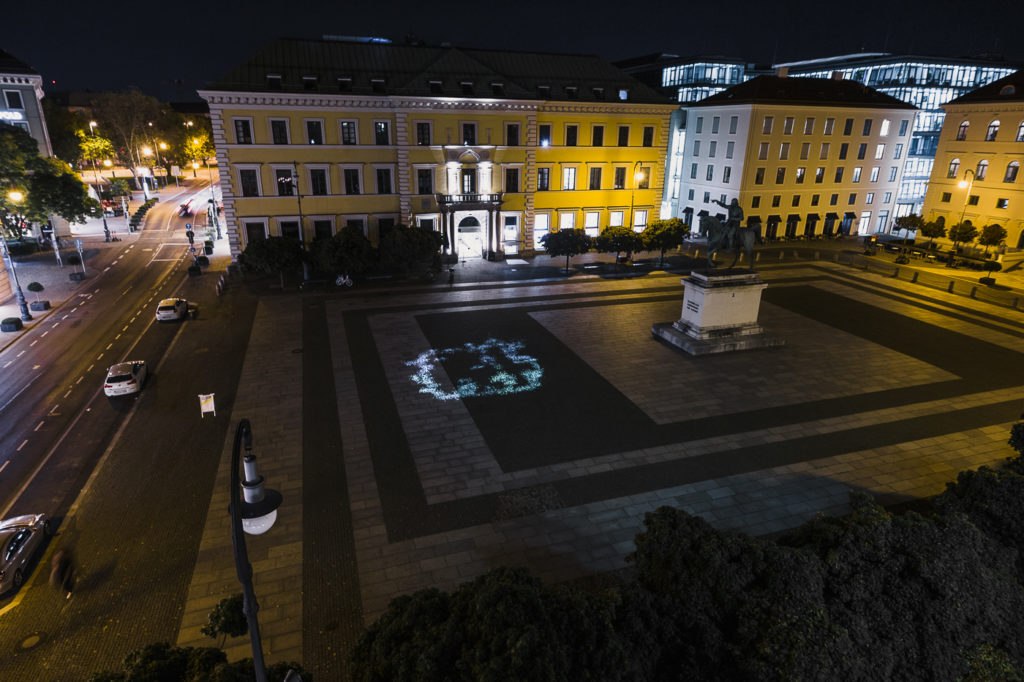
Concept
The art project in public space EASTERN MUNICH deals with the themes of inter-culturality and inter-religion in urban space, focusing on the German metropol Munich. At its heart lies the question of how religion and culture manifest in urban space and society. Sacred buildings and prayer rooms are interpreted as central spaces of (monotheistic) religions. For many people in modern urban society, however, these are perceived as detached and “closed” spaces, which despite their presence in Munich’s cityscape, are associated with an unconscious inhibition threshold in everyday life – or are a blind spot. Also, sacred buildings are visited by a few people only, even believers, and despite their density – apart from tourist attractions such as the Catholic Frauenkirche (Church of Our Lady) – are hardly noticed or literally secluded. Moreover, religious people mostly visit the sacred spaces in their respective church, synagogue or mosque. Thus religions within a big city ultimately remain separate, opaque and often misunderstood in their respective peculiarity and potential.
The intervention EASTERN MUNICH breaks these barriers down these and opens up a new intuitively accessible space of experience.
The basis of artistic form is light. The floor plans of various past, present and future religious buildings and spaces from Munich are projected in large-scale video projections onto the floor of Wittelsbacherplatz in the heart of the city. By superimposing, interpolating and interpolating the projections of life-size 1:1 sacred space floor plans in public space, they are not only brought to light and become visible, but also turn into an “accessible” sphere, literally opening them up on the ground and facades at Wittelsbacherplatz – inviting border crossing through unfolding an open light space of actual and virtual sacred spaces in Munich.
In this way, EASTERN MUNICH provokes a new experience: What are the peculiarities, similarities and differences of the monotheistic religions that are reflected in their sacred buildings in the cityscape? What asymmetries arise between the visibility in the cityscape of Munich and the presence of religion(s) in public discourses? What influence do these tensions have on society’s perception of culture, religion and inter-religiousness? How can past (destroyed), present and future (virtual) relationships be experienced and what tensions arise from them? Where are psychological boundaries drawn and where are frontier crossings necessary and possible?
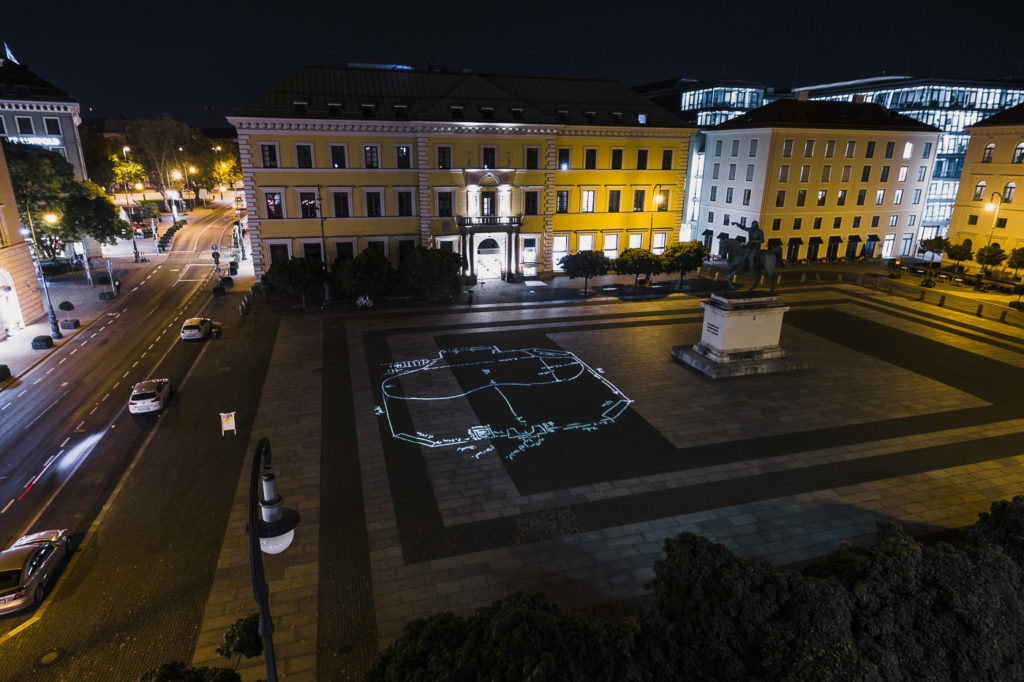
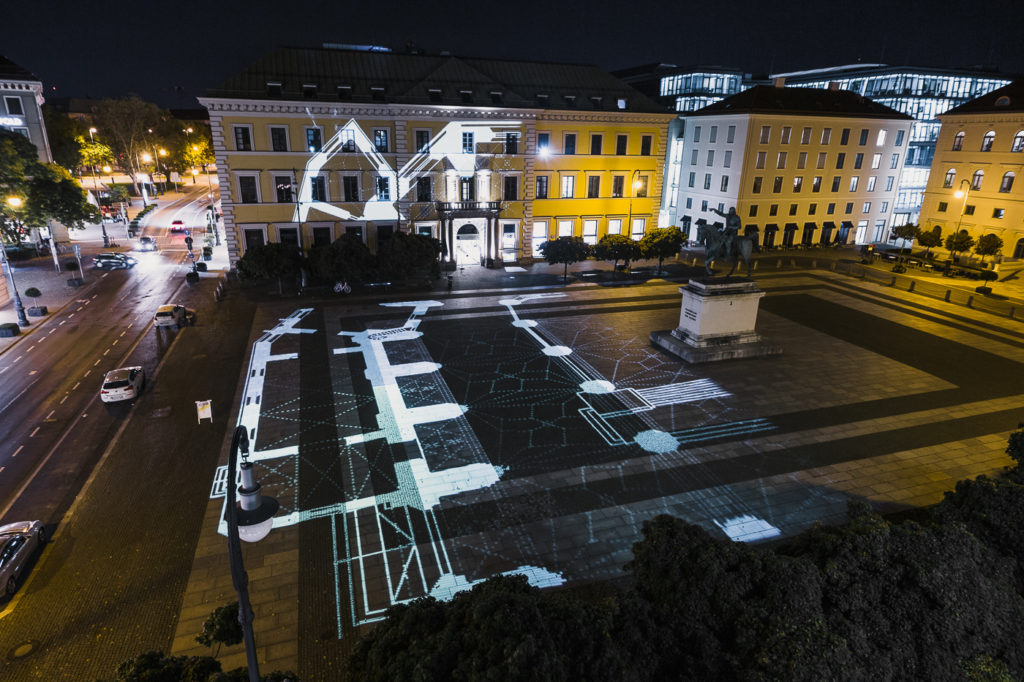
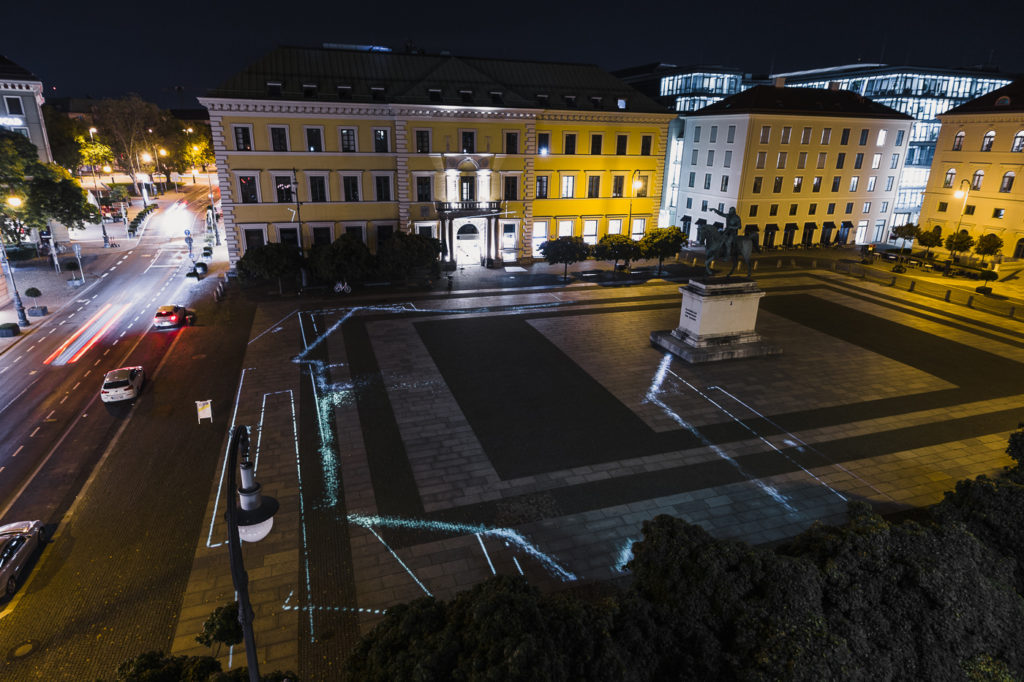
Extract out of raw essay to be published in May 2020 by Prof. Michael Reder
“[…] The philosopher Jürgen Habermas, one of Germany’s leading intellectuals, who, following up on a quote by the (religious) sociologist Max Weber, describes himself as “religiously unmusical”, stressed a few years ago in Munich in his conversation with the former Cardinal Ratzinger that secular societies should also adapt to the persistence of religion. Even more: they make important contributions in context of the complex problems of global modernity.
15 years later his thesis of a post-secular society more than proved true; especially the monotheistic religions are – still – important actors of our society and contribute to the handling of their hurdles and challenges. Nevertheless, for many people in modern society they are “closed” and incomprehensible spaces, even if they strongly shape the cityscape of Munich. In public debates, the conflict over religions is at the forefront, especially in the media context, which means that the cultural potential of religion remains underestimated and untapped, especially in a plural modern society.
Against this background, the interdisciplinary art project EASTERN MUNICH aims to break down the boundary between monotheistic religions and the public space of society. The initially seemingly minimal and “superficial” projection of various floor plans of sacred spaces and buildings allow a large number of people a sensual, intuitive and low-threshold access to these virtual architectural manifestations.
By simply “stepping in” from a public square or pedestrian zone “into” the sacred “space”, the white projection lines open up a sensual journey of discovery; by transforming massive matter into ephemeral lines of light, closed space into open space. This kind of art in public space is an effective form to express the complexity of religions in their interreligious contexts and controversial tension precisely through its simplicity, clarity and sharpness. By shifting, superimposing, revealing sacred spaces, an examination of the theme of religion – a central cultural actor of our time – becomes experienceable. […]”
Initiator & Partner
whiteBOX / Munich School of Philosophy
Sponsors
Kulturreferat der Landeshauptstadt München / Kulturstiftung der Stadtsparkasse München / innogy Stiftung für Energie und Gesellschaft / Erzbistum München und Freising: Referat für interreligiösen Dialog und die Abteilung für Kunst- und Kulturmanagement
Supporters
Lange Nacht der Museen / Münchner Forum für Islam
Evang.-Luth. Kirchengemeindeamt im Dekanatsbezirk München; Abteilung Bau und Liegenschaften, Erzbischöfliches Ordinariat München; Bauwesen und Kunst.
Special thanks
in no particular order, among others: Dr. Martina Taubenberger, Prof. Michael Reder, Dr. Andreas Renz, Benjamin Idriz, Andrea-Elisabeth Lutz, Ursula Gonsior, Stefan Neukamm, Liberale jüdische Gemeinde München Beth Shalom e.V., Aykan Inan, Sheikh Taha Zeidan, Elmedin Haskić, Sulejman ef. Čolaković, Gabriele Musil, Valerie Erben, Mehtap von Stietencron, Juliana Bertsch, Swen Seyerlen, Benjamin Jantzen, Adriana Lemus, Thomas Schmidt, Anna Schwab, Benita Meißner, Cagla Ilk, Julian Prugger, Max Hohl, Stephan Lechner, Horst Sandner, the Bavarian Ministry of the Interior, Sport and Integration, SKW Schwarz Rechtsanwälte – München, and many others, especially to all the individual backers – also within the Jewish, Muslim and Christian communities of Munich – who participated and supported the project (to be extended).
Photos © Lia Sáile, Lisa Domin, Michael Reder, 2019
